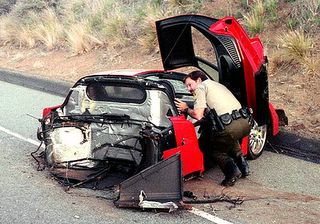
Ferrari Crash PCH

Ferrari Ruins
More news about that amazing Ferrari crash last month on Pacific Coast Highway in Los Angeles.
Video May Hold Clues to PCH Wreck
L.A. County sheriff's officials say two men who crashed a rare Ferrari in Malibu last month may have been filming the incident.
The Los Angeles County Sheriff's Department's investigation into a mysterious crash that destroyed a rare $1-million Ferrari in Malibu last month is now focusing on a videotape that was purportedly shot from inside the vehicle at the time of the accident, according to sources close to the case.
The sources said that Ferrari owner Stefan Eriksson and the other man in the car, identified by authorities as Trevor Karney, had a video camera rolling as they raced on Pacific Coast Highway on the morning of Feb. 21 at speeds in excess of 162 mph.
Deputies who arrived at the scene did not recover any video equipment. But sources said detectives were later told that the high-speed driving was taped. The sources spoke on the condition of anonymity because the case is under investigation.
The revelation is the latest twist in a crash that has prompted both an accident investigation and a probe by the Sheriff's Department's Homeland Security Division.
Although no one was injured in the crash, the investigation has generated significant attention because of the strange circumstances and the fact that it destroyed one of only 400 Enzo Ferraris ever made.
Eriksson, a former European video game executive, told deputies who arrived at the scene that he was not the driver and that another man, named Dietrich, was behind the wheel. Eriksson said Dietrich fled the scene.
But detectives have always been skeptical of his version of events. Investigators have taken a swab of Eriksson's saliva to match his DNA against blood found on the driver's side air bag of the Ferrari.
Eriksson also told deputies that he was a deputy commissioner of the police department of a tiny transit agency in the San Gabriel Valley.
A few minutes after the crash, two men arrived at the crash scene, identified themselves as homeland security officers and spoke to Eriksson at length before leaving.
Sheriff's Sgt. Phil Brooks said Wednesday that a few weeks before the accident, Eriksson was pulled over in West Hollywood without a driver's license.
At that time he told officers that he was a deputy police commissioner of the anti-terrorism unit of the San Gabriel Valley Transit Authority and showed a badge, Brooks said.
Before coming to the U.S., Eriksson lived in England. According to Noel Hogan, a British private investigator, formerly with Scotland Yard, Eriksson once told him that he was a police officer. Hogan had been trying to recover a Mercedes SLR worth more than $450,000 that had been reported stolen in England and which Eriksson had in his possession.
Officials at the transit agency, which provides transportation for the disabled and elderly from Monrovia, said Eriksson was given the title of deputy police commissioner after undergoing a background check and offering the agency free video security cameras for its five buses.
Eriksson left video game machine manufacturer Gizmondo last fall after a Swedish newspaper printed allegations of his criminal past.
L.A. Times Link

